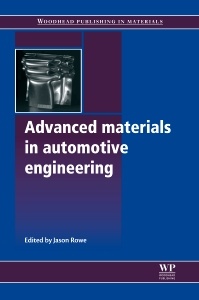Description
Advanced Materials in Automotive Engineering
Coordinator: Rowe Jason
Language: English
Subject for Advanced Materials in Automotive Engineering:
Support: Print on demand
Description
/li>Contents
/li>Biography
/li>Comment
/li>
Contributor contact details
Chapter 1: Introduction: advanced materials and vehicle lightweighting
Chapter 2: Advanced materials for automotive applications: an overview
Abstract:
2.1 Introduction
2.2 Steels
2.3 Light alloys
2.4 Stainless steels
2.5 Cast iron
2.6 Composite materials
2.7 Glazing materials
2.8 Conclusions
Chapter 3: Advanced metal-forming technologies for automotive applications
Abstract:
3.1 Formability
3.2 Forming technology
3.3 Modelling
3.4 Economic considerations
Chapter 4: Nanostructured steel for automotive body structures
Abstract:
4.1 Introduction
4.2 Potential demand for nanostructured steels for automotive body structures
4.3 Fabricating nanostructured low-C steel sheets
4.4 Improving elongation in nanostructured steel sheets
4.5 Crash-worthiness of nanostructured steel sheets
4.6 Conclusions
4.8 Appendix
Chapter 5: Aluminium sheet for automotive applications
Abstract:
5.1 Introduction
5.2 Sheet alloys for outer applications
5.3 Sheet alloys for inner closure panels and structural applications
5.4 Fusion alloys
5.5 Surface treatment of the aluminium strip
5.6 Future trends
Chapter 6: High-pressure die-cast (HPDC) aluminium alloys for automotive applications
Abstract:
6.1 Introduction
6.2 AlSi heat-treatable alloys – Silafont®-36
6.3 AIMg non heat-treatable alloys – Magsimal®-59
6.4 AlSi non heat-treatable alloys – Castasil®-37
6.5 Automotive trends in die-casting
Chapter 7: Magnesium alloys for lightweight powertrains and automotive bodies
Abstract:
7.1 Introduction
7.2 Cast magnesium
7.3 Sheet magnesium
7.4 Extruded magnesium
7.5 Future trends
7.6 Acknowledgments
Chapter 8: Polymer and composite moulding technologies for automotive applications
Abstract:
8.1 Introduction
8.2 Polymeric materials used in the automotive industry
8.3 Composite processing procedures
8.4 Fields of application for fibre-reinforced polymer composites (FRPCs)
8.5 Further challenges for composites in the automotive industry
Chapter 9: Advanced automotive body structures and closures
Abstract:
9.1 Current technology, applications and vehicles
9.2 Key factors driving change and improvements
9.3 Trends in material usage
9.4 Latest technologies
Chapter 10: Advanced materials and technologies for reducing noise, vibration and harshness (NVH) in automobiles
Abstract:
10.1 Introduction
10.2 General noise, vibration and harshness (NVH) abatement measures
10.3 Selected concepts for noise, vibration and harshness (NVH) control
10.4 Applications
10.5 Conclusions
10.6 Acknowledgements
Chapter 11: Recycling of materials in automotive engineering
Abstract:
11.1 End of life vehicles (ELVs)
11.2 Reuse, recycle or recover?
11.3 Environmental impact assessment tools
11.4 Case study – the WorldF3rst racing car
11.5 Conclusions
Chapter 12: Joining technologies for automotive components
Abstract:
12.1 Introduction
12.2 Types of advanced structural materials in cars
12.3 Factors affecting the selection of joining methods
12.4 Joint design and joint surfaces
12.5 Laser beam welding (LBW) and brazing/soldering
12.6 Adhesive bonding
12.7 Mechanical joints
12.8 Hybrid joining methods
12.9 The effect of volume on joining technology
12.10 Future trends
Index
- Explores the development, potential and impact of using advanced materials for improved fuel economy, enhanced safety and effective mission control in the automotive industry
- Provides a comprehensive introduction to advanced materials for vehicle lightweighting and automotive applications
- Covers a range of design ideas and manufacturing issues that arise when working with advanced materials, including technologies for reducing noise, vibration and harshness, and the recycling of automotive materials




